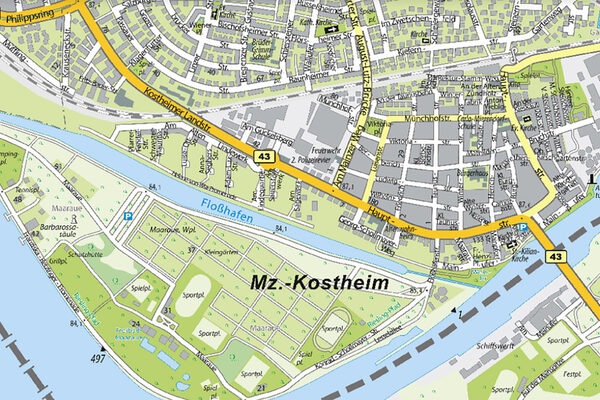Kostheim: At the mouth of the river: Copsistaino
The oldest traces of human settlement in Kostheim date back to the Bronze Age.
Early history and Roman times
The Roman period was particularly formative: the town was an important military base and secured a wooden bridge over the Main. Remains of this bridge and other archaeological finds attest to Kostheim's strategic importance at the mouth of the river.
Economic roots: agriculture, viticulture and rafting
Kostheim was first mentioned in a document in 790, when Charlemagne issued a document in "Copsistaino". The name is probably derived from "caput stagni" (head at the swamp).
Kostheim was a center for agriculture and fruit and wine growing for centuries. A Kostheim skipper is mentioned as early as 1281. There is evidence that a mill has existed since 1293. In 1662, the fisherman Lorenz Rhein joined the Mainz fishermen's guild. The strategic location at the confluence of the Main and Rhine made the town an important transshipment point for goods. From the 16th century onwards, rafting also developed into an important industry that shaped the region and contributed to Kostheim's economic diversity.
Wars and destruction
Throughout its history, Kostheim has often suffered from the turmoil of war. The town was particularly hard hit during the Thirty Years' War. The Swedes built the Gustavsburg fortress in the neighboring district. The Napoleonic Wars (1803-1815) also caused severe damage - Kostheim was repeatedly the scene of battles and was destroyed several times.
Upswing in the 19th century
Kostheim experienced an economic boom with industrialization. The opening of the Taunus Railway (1840), the construction of the Main Bridge (1887/89) and the establishment of industrial companies such as the cellulose factory (1885) changed the townscape forever. The Kostheim match factory was built in 1887 and employed around 100 people, mostly women. Production ceased at the end of 1930. New residential areas were built and the population grew. In 1913, Kostheim was incorporated into the city of Mainz.
Second World War and reorganization
The Second World War brought with it severe destruction. The old town and Hochheimer Strasse were particularly affected. 113 people lost their lives in air raids. After the end of the war, Kostheim was separated from Mainz in 1945 and assigned to Wiesbaden - a political reorganization that is still in place today.
Today: tradition and modernity
Kostheim has developed into a popular place to live. The town is known for its winegrowing tradition, which dates back to the Middle Ages. Farm festivals and the winegrowers' festival on the banks of the Main reflect this living tradition. Residents benefit from the proximity to Wiesbaden and Mainz, which provide both economic and cultural stimuli.
Historical highlight
Two crossed vine knives or one pair of pliers? Opinions differ. In any case, the symbol was discovered on a boundary stone from 1603 and incorporated into Kostheim's coat of arms.
